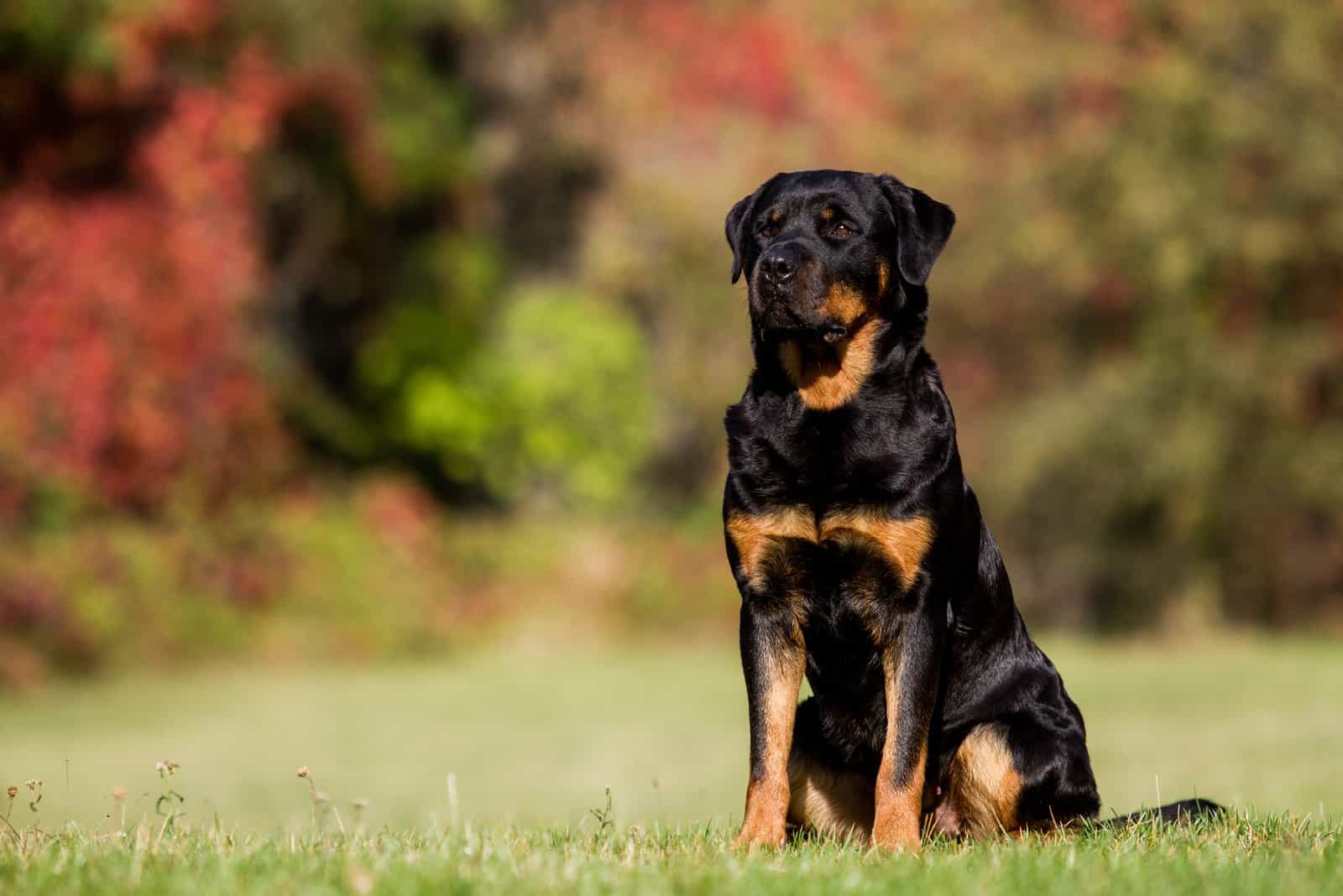Ah yes, we finally get to talk about the mighty Rottweiler dog breed! And what better way to get to know such an amazing breed, than to learn more about its growing up phases.
Through physical development, Rottweiler puppies gain weight, strength, stamina, and proper muscle mass. However, mental growth is as important as body growth. The two follow one another.
To distinguish a healthy Rottweiler puppy growth from an unhealthy one, we have come up with this detailed Rottweiler growth chart.
Not only are we going to talk about numbers, ounces, pounds, and inches, but we are also going to mention common Rottweiler health problems.
In addition to that the Rottweiler growth chart contains tips and tricks that will help your Rottie grow into a beautiful adult dog.
So, buckle up, because we are taking off to a Rottweiler puppy journey!
Rottweiler Puppy Growth Chart: Male And Female
The Rottweiler is a large dog breed that belongs to the working dog group. Working dogs were originally bred to achieve a strong physique that would aid in helping humans with work. So, the Rottie was primarily bred for its size, strength, and temperament.
This Rottweiler puppy growth chart covers both male and female Rottweiler puppies’ average weight and height.
You might guess that there is a huge difference in growth and size between male and female Rotties.
To check if you are right, take a closer look at the following table.
Age Male Rottweiler Puppy Size Female Rottweiler Puppy Size
[table id=438 /]
As you can see, male and female Rottweiler puppies don’t differ much in terms of their size. Let’s see how much a healthy Rottweiler puppy weighs.
Rottweiler Puppy Weight Chart
To fully understand how much a Rottweiler puppy grows, we need to measure their weight every week. By following the Rottweiler puppy weight chart you will be able to predict your Rottie’s weight in no time.
Age Male Rottweiler Puppy Weight Female Rottweiler Puppy Weight
[table id=439 /]
Did you notice that a Rottweiler puppy gains up to two pounds each week?
This is due to the characteristic rapid growth that is usually seen in large dog breed puppies. Such growth will continue up until eight or nine months of age.
So, now that you have seen how much a Rottweiler puppy should weigh, it’s time to state some facts between male and female Rottweilers.
Rottweiler Growth Chart: Male Vs Female
In terms of Rottweiler weight and height, as well as physical appearance, there are some differences between male and female dogs. Firstly, the male Rottweilers are a few inches taller than their female counterparts. They are also a few pounds heavier.
When it comes to secondary sex characteristics, that are under the influence of sexual hormones, we can see differences in the Rottie’s body shape. For example, female Rotties are slimmer and less bulky than the male Rottweilers.
Let’s talk about their size differences by using these male and female Rottweiler growth charts below!
Male Rottweiler Growth Chart
Male Rottweilers are usually larger than females and they tend to grow faster. In addition to their rapid growth, male Rottweilers also behave differently from their female counterparts.
[table id=440 /]
Usually at about seven months of age, male Rottweiler puppies’ growth rate declines. They will keep gaining weight, but will not grow more than one to two inches in height.
Female Rottweiler Growth Chart
Although female Rottweilers are almost the same height as males, they never weigh the same as male Rottweilers. Unless the female Rottie is obese.
Here are the physiological estimest of average weight and height of a female Rottweiler dog.
[table id=441 /]
The female Rottie’s body is usually sleeker and more feminine than her male counterpart. The Rottweiler breed is one of those dog breeds in which you can clearly see the difference between a male and a female Rottie when standing next to one another.
How Quickly Do Rottweilers Grow?
You may wonder how Rotties grow so big in size? Here is a thing about large dog breed puppies.
Rottweiler’s genes carry large size traits. But, there are other key factors that play a big role in its big size.
Alongside genetics, the reason behind a rapid growth lies in its environment.
Rapid growth makes large dogs grow very fast in a short time. Although they grow big, large dogs don’t mature until a few months after reaching adult size. What’s specific about large dog breeds like the Rottweiler is that they usually mentally stay little puppies. So a Rottie might be large in size, but still act as a big baby.
When you take a closer look at these Rottweiler average weight and height charts, you notice that after seven months of age, the Rottweiler puppy seems to stop growing in height and size.
The closer the Rottie is to its full size, the slower its growth rate becomes.
Another thing about a large dog like the Rottie is that it always seems to think that it’s the perfect lap dog.
Although perfect, Rotties are definitely not lap dogs. I mean, how do you expect a 100 pound Rottweiler to fit on your lap?
Rottweiler Puppy Growth Stages
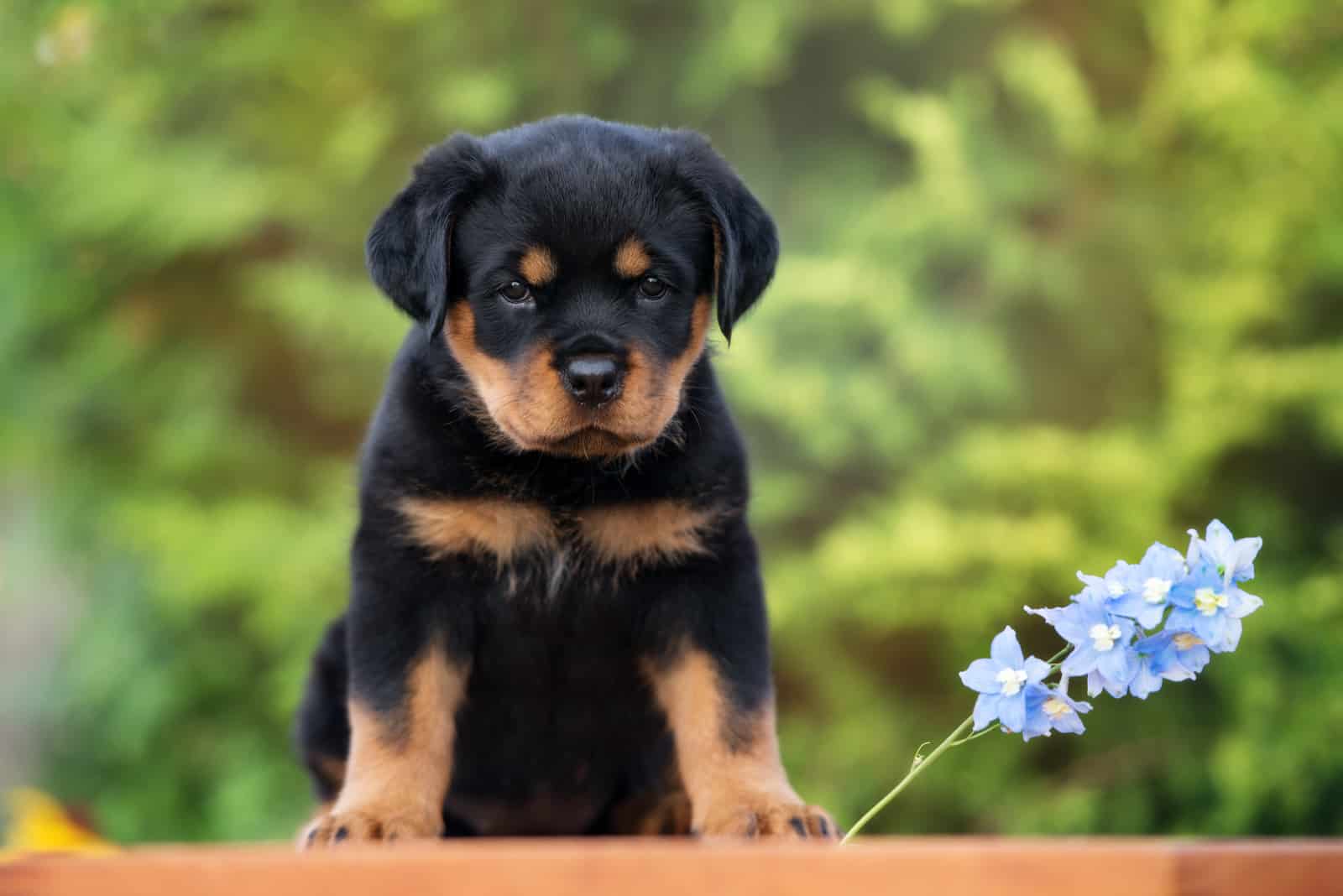
During the first year of life, a Rottweiler puppy goes through many mental and physical changes. In this Rottweiler growth chart, we are going to focus more on the physical changes.
We will follow the puppy’s development through Rottweiler puppy growth stages. Alongside growth, you will find out about the Rottweiler puppy’s behavioral changes during the first year of its life.
Here is how little Rottweiler puppies grow up into large working dogs.
Newborn Rottweiler Puppies
At birth, a baby Rottweiler puppy weighs only a pound. But, not all newborn Rottweiler puppies weigh the same.
Some Rottweiler puppies — especially male puppies, are most likely to be heavier than females. At birth, Rottweiler male puppies can weigh up to two and 2.5 pounds.
Sometimes there is going to be a Rottweiler runt puppy in the litter. The occurrence of runt puppies depends on the difficulty of pregnancy and labor. It also depends on the Rottie mom and dad’s genetics.
The Rottweiler mom carries six to twelve puppies on average. Unfortunately, there are times when the Rottweiler dog eats the newborn puppies. As bizarre as it sounds, we have to accept that this is normal in the canine world.
So, the first two to six days of life may be hard on little Rottweiler puppies. Not only do they cry and fight with one another, but some Rotties get their tails docked. Rottweiler breeders prefer having their puppies’ tails docked. This procedure is usually done when Rottweiler puppies are two to six days old.
Baby Rotties are dependent on their mom for quite some time. After two weeks of age, all Rottweiler puppies should open their eyes.
So, what about the puppy weight? Well, two week old Rottweiler puppies already weigh between three to four pounds!
At two weeks of age, you will notice that your Rotties are starting to learn how to walk!
Four Weeks To Eight Weeks
Rottweiler puppies stop nursing around four weeks of age. That said, a four week old Rottie weighs between five and six pounds. It has already gained some weight, right? And this is only the beginning of its growth!
A big puppy growth spurt is noticed between four and eight weeks of age. By using our Rottweiler growth chart, you can see that at eight weeks of age, its size more than doubles.
At eight weeks of age, the Rottweiler puppy weighs from 12 to 16 pounds. Now it can slowly start transitioning to a mixture of wet dog food and dry dog food.
Oh, and when Rotties discover tasty dog food, they will require up to five small meal portions throughout the day!
Not only does a Rottweiler puppy grow very quickly, but it is also getting old enough for its first vaccination.
Moreover, the period between four and eight weeks is crucial for a Rottie puppy’s mental growth. In this timeframe, a Rottweiler puppy is eager to learn and show its intelligence. But, the puppy is very restless and energetic. So, training and proper socialization might take a while.
This is why I always advise dog owners to work intensively with their Rottie pups as early as from four weeks of age. At eight weeks of age it is expected that a Rottweiler puppy is already socialized.
This puppy age is the best for molding your Rottweiler puppy and getting it used to your lifestyle and habits.
Another cool thing is that by eight weeks of age, your Rottie has its biorhythm all sorted out. What this means is that you won’t have any more problems with the Rottweiler puppy crying at night.
Four Months To Six Months
At four months of age, a female Rottweiler weighs around 35 to 37 pounds. On the other hand, the male Rottweiler puppy is remarkably heavier, weighing a whopping 50 pounds. As for her height, a four-month old female rottweiler stands 19 inches tall and her male counterpart is an inch taller.
So, how big is a 6 month old Rottweiler?
When it reaches its six-month birthday, a Rottweiler puppy weighs around two-thirds of its adult weight. A six month old Rottweiler reaches between 63 and 75 pounds.
The period between four and six months is when dog owners usually start to lose it. During this period, their Rottweiler puppy is going crazy around the house!
Both male and female Rottweiler puppies continue to rapidly grow as they change behavior. The period between four and six months marks preparation for your puppy’s adolescence phase. Keep your patience, because your puppy will soon hit puberty.
Its behavior changes — well for the worst. Most dog owners who went though this puppy phase know that their puppy was once a troublemaker.
A six-month old Rottweiler puppy will get its teeny tiny teeth on everything. It won’t choose between you and its favorite chew toys. This is the perfect opportunity to teach your puppy to stop biting you.
Note that Rottweiler puppies get bored very easily, so your main focus during this period should be to teach your six-month old Rottie the do’s and don’ts around the house.
If you thought that the Rottweiler puppy growth chart ends here, then you’re pretty wrong. After six months of age, a Rottweiler puppy gains approximately five pounds each month until it reaches its adult weight.
Seven Months To Nine Months
Expect your seven-month old Rottweiler puppy to weigh between 75 and 92 pounds. In large breeds, seven months of age marks the finishing phase of the puppy’s rapid growth. Your seven-month old Rottie now stands 24 to 25 inches tall.
You know how some teenagers are skinny because of their rapid growth period? Well, you can expect your teenage Rottweiler puppy to be a bit skinny too. But, don’t worry your Rottie is not underweight. It has just grown so big, that its body fat didn’t have enough time to accumulate.
From this point, your Rottweiler puppy won’t grow as much as it did in the period between four to six months. But, it will keep gaining healthy weight.
A nine-month old Rottweiler male puppy stands up to 25 inches in height. The height of a nine-month old Rottie female is only an inch less. Their weight ranges between 80 to a whopping 100 pounds.
Your Rottie has almost reached its adult height and adult weight.
Twelve Month Old Rottweiler
We have finally come to the last phase of the Rottweiler puppy growth. 12 months of age is when the Rottweiler puppy reaches its full size. In other words, a one year old Rottweiler isn’t a puppy anymore, but an adult.
The adult weight of a female Rottweiler is between 93 and 102 pounds, whereas the adult weight of a male Rottweiler ranges from 110 to 120 pounds.
Although they are large dogs, they’re not as tall as Great Danes or St. Bernards. A female Rottweiler reaches 25 inches in height as her male counterpart follows standing 26 inches tall.
When Do Rottweilers Stop Growing?
Technically, Rotties stop growing and reach their full weight around one year of age. If you notice that your Rottie is larger than what you expected, there is a chance it will still keep growing.
Some Rottweiler puppies may postpone their adulthood. It might take more than a year for your Rottweiler puppy to reach its full size. That’s nothing to worry about. Some Rottweilers keep growing until they are two years old!
A few sources state that a Rottweiler dog doesn’t stop growing until it reaches three years of age!
Rottweiler Health Problems
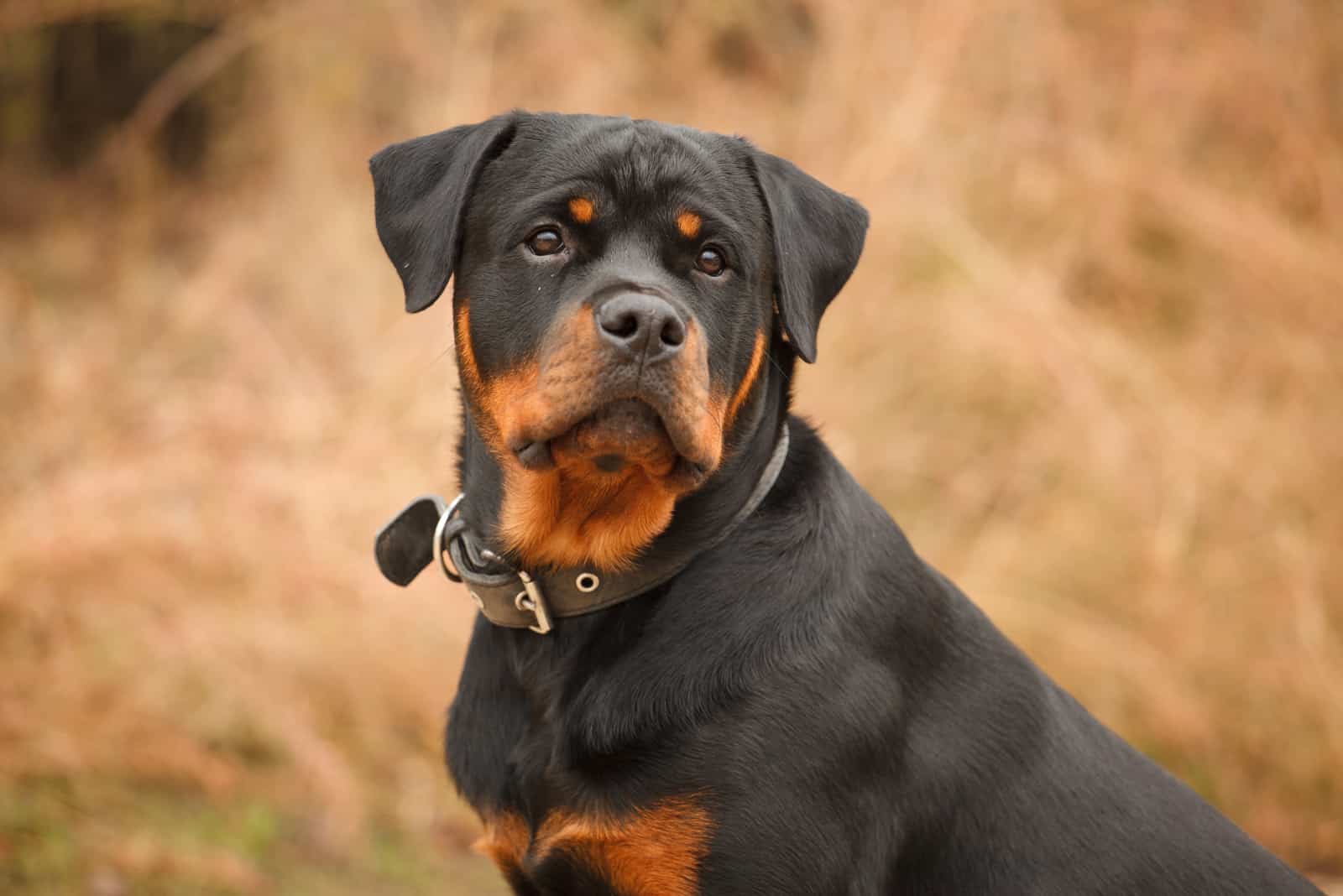
Whether the Rottweiler dog breed is healthy or not it’s quite debatable. Some Rotties almost never develop a health problem during their lifetime. On the other hand, there are Rotties who suffer from various breed-specific health problems. A Rottweiler puppy may show signs of illness as early as eight weeks of age.
The Rottweiler’s health condition greatly depends on its size.
Common health problems include eye conditions such as progressive retinal atrophy (PRA), and cataracts, as well as gastrointestinal problems. Most large dog breeds have higher risk of developing gastric dilatation (bloat).
Large dogs develop large bones, right?
Yes, but certain problems may occur during their development. For example, hip dysplasia is the most common health problem of large dogs and unfortunately, it does not skip our Rottweiler dog breed.
Joint Problems
Let’s talk about a very serious health condition that often affects the Rottweiler breed — joint problems.
Unfortunately, joint problems such as dislocations affect our Rotties more often than we expected.
Even though we know that large dogs often suffer from joint problems, we kind of hoped that our Rottie wouldn’t have such troubles during its lifetime. But, it turns out that Rottweilers are very prone to joint problems.
So, it’s good to know a thing or two about this common Rottie health issue.
Joint dislocations in dogs hurt a lot. If you ever had your joint dislocated, you feel the pain by just remembering it. Joint problems can occur during physical activity, minor injuries, old age, as well as falling from a couch.
Due to the fact that the Rottweiler is a large dog, its weight puts pressure on the affected limb and eventually causes the joint to move out of its socket.
If left untreated, this health problem can lead to arthritis, which is even more painful for the dog. So, please take care of your dog, especially during its puppyhood.
Hip Dysplasia
The joint dislocation is commonly referred to as hip or elbow dislocation, because it usually affects the dog’s hips and elbows. We already read a lot about it in large dog breeds that are more prone to it than small dogs.
Hip dysplasia in dogs is quite a common health problem. And this health problem is linked with growth. When large breeds like the Rottweiler grow, their hip joints sometimes don’t grow as planned. In other words, the bones forming the hip joint don’t grow equally fast.
Hip Dysplasia in Rottweilers is a breed-specific health problem. Most reputable Rottweiler breeders have their dogs tested against such congenital health conditions.
Genetics aren’t the only culprit in hip dysplasia. Other factors like inadequate diet, bad environment, and insufficient physical activity play a role in the development of this health problem during the dog’s growth.
Obesity
Obesity can affect all dog breeds. But, some breeds are more prone to it than others. Dogs like Labrador Retrievers, German Shepherds, as well as our Rotties are very prone to obesity.
An obese Rottie will have trouble moving around. So, now you have a dog with less physical activity. As days go by, the Rottweiler puppy won’t move as much as it should.
If a Rottweiler puppy gets obese before reaching its adult size, this might cause long-term health problems.
Health problems that are linked to obesity in dogs are heart conditions, liver problems, diabetes, weak muscles, trouble breathing, problems with blood pressure and many more.
As your Rottie puppy grows, it will want to eat bigger amounts of dog food. But, it will also want to have more frequent meals. So, make sure not to overfeed your lovely pooch.
As a responsible dog owner, your job is to pay attention to what you feed your Rottweiler puppy. I had most dog owners come to me and ask “What can I feed my dog?” and the answer to this question is really simple.
Any kind of dog should be fed a balanced diet. For your Rottweiler puppy to gain healthy weight, feeding it with quality puppy food is essential. Especially after it has transitioned from its mother’s milk.
This rottweiler growth chart can help you keep track of the Rottweiler puppy’s healthy weight gain, while you can use the Rottweiler feeding chart for more useful information on this dog’s nutritional needs.
Rottweiler Body Condition Score
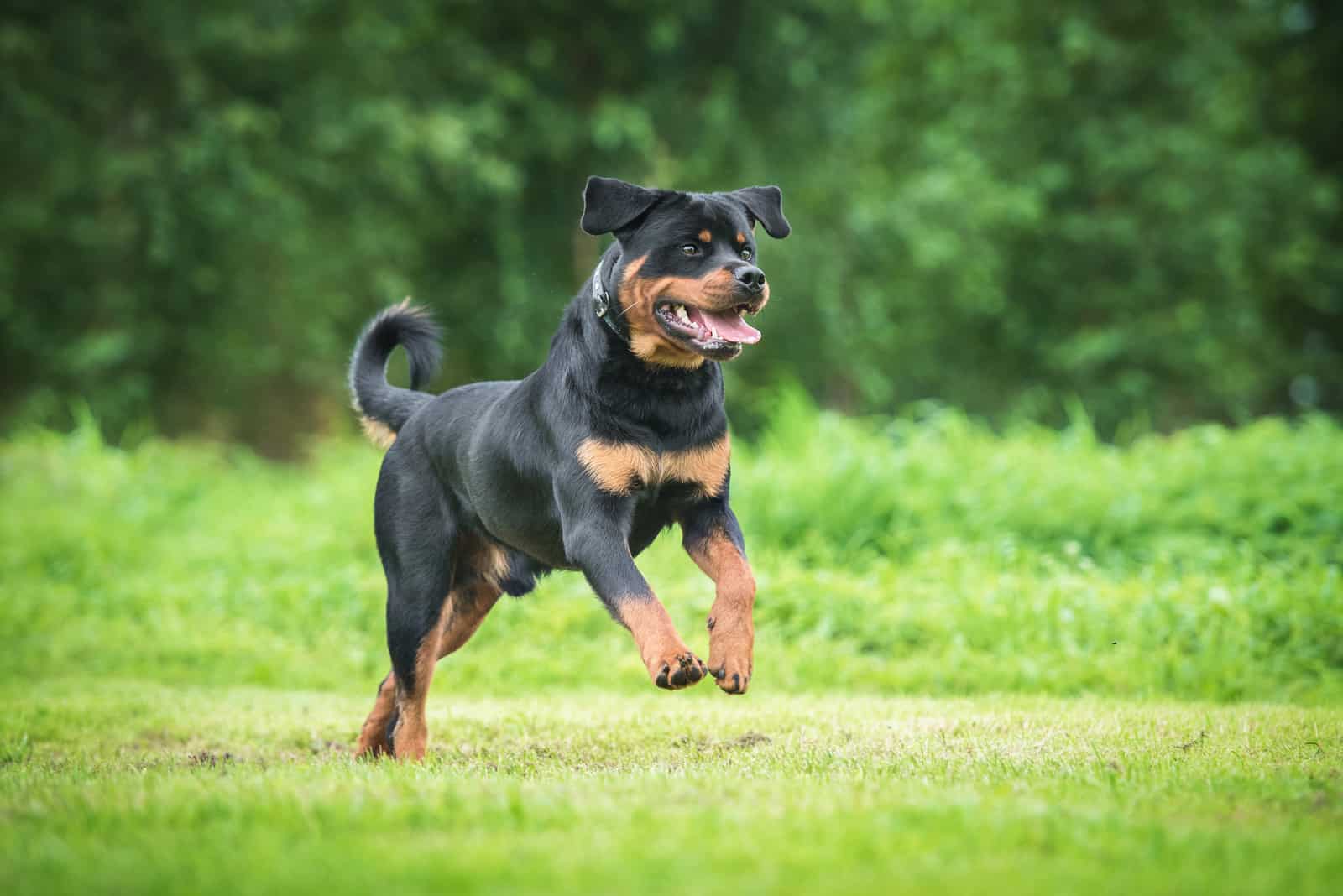
To see if your dog’s weight is healthy, you can check out the Rottweiler’s body condition score.
The Rottweiler BCS is an ideal tool to use to determine whether your dog is underweight or overweight. In other words, BCS shows the ideal weight of your Rottie.
The body condition score shows numbers from one to nine. These numbers are points that present your Rottie’s body condition.
The first three BCS points describe an underweight dog with almost no fat on its body. In such dogs, ribs and hip bones are visible.
BCS points from four to six show the ideal body condition of your Rottie. This is exactly how you want your Rottie to look like. Everything above these scores is considered overweight and obese.
Effects Of Neutering/Spaying On Rottweiler Puppy Growth
Male and female hormones are part of what keeps the Rottweiler puppy growth going. Remove them too early, there is most likely going to be a stagnation in your pup’s development.
Testosterone is a male hormone that is produced and released thanks to the testicles. When testicles are removed, the testosterone levels greatly decrease. Same goes with estrogen, except it’s produced and regulated by ovaries. With the removal of ovaries in female Rottweilers, estrogen hormone levels in blood decrease.
If you don’t plan to breed your female Rottweiler puppy, it’s best to have her spayed when she reaches her first birthday. Male Rottweiler puppies should be neutered between twelve and eighteen months of age.
Spaying/neutering your Rottie too early increases the risk of developmental problems. In addition to that, studies show that early spaying/neutering causes tumors in the Rottweiler dog breed.
Read More: Will Neutering My Rottweiler Calm Him Down? Detailed Answer
Some veterinarians prefer to spay/neuter Rotties when they are two years old. In any case, it’s best to have them spayed/neutered after twelve months of age. There is no reason to hurry with this procedure.
Healthy Rottweiler Puppy Growth: Tips And Tricks
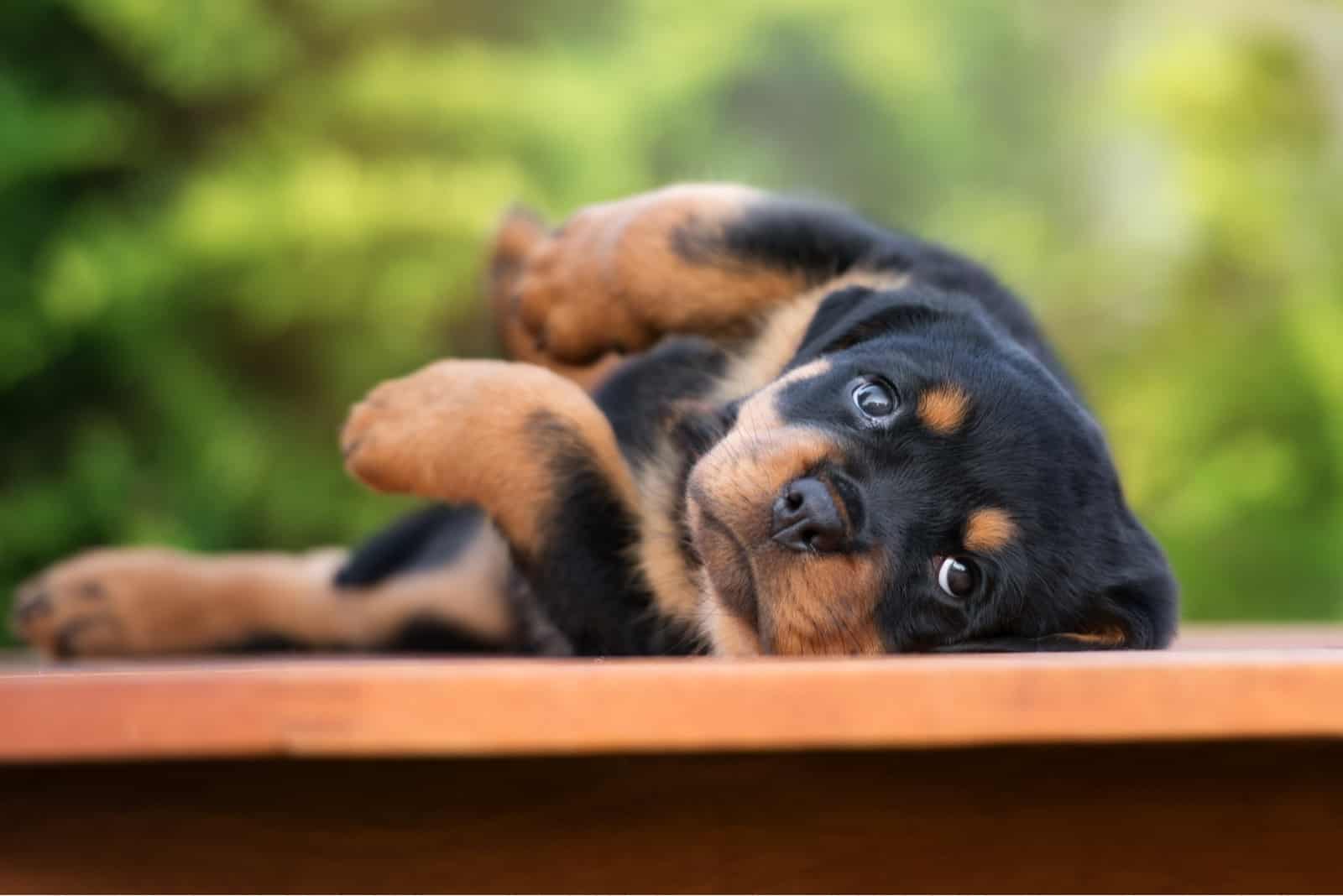
Reading about Rottweilers’ health problems is quite worrying. Due to the fact that many health problems may develop during the Rottie’s first year of life, it’s best to provide you with some tips and tricks on how to raise a healthy Rottweiler puppy.
Not only is this helpful for new dog owners, but it can also help aspiring Rottie owners to see what it takes for a healthy puppy growth.
Therefore, before getting a Rottweiler puppy, make sure you are able to provide it with following:
Maintain A Healthy Rottie Diet
Feed your Rottweiler puppy only the most high-quality puppy food. Nourish your Rottweiler puppy with dog food that is rich in quality protein, calories, vitamins, and healthy fats. If you decide to transition your Rottie to a raw diet, consult your Rottweiler breeder and your veterinary nutritionist. Although it has many benefits, not all Rottweiler puppies are going to take it well.
Include dietary supplements into your Rottie diet. If your Rottweiler puppy needs a little help during its growth, provide it with the best dog supplements. It’s best you consult your veterinarian about choosing the right puppy supplement.
Avoid giving your puppy too many treats during positive reinforcement training. Too much of anything isn’t good.
Avoid giving your Rottweiler puppy tables scraps and other human foods. It is extremely important to note that certain human foods are toxic for dogs. So, no. Your Rottweiler puppy shouldn’t eat tortillas for lunch.
Don’t overfeed your dog. You already know that you should feed your dog the best dog food you can find. But, don’t make huge portions of it.
Opt for multiple smaller meals throughout the day. Large portions of food, followed by immediate physical activities elevate the risk of bloat and gastric volvulus dilatation in Rottweilers.
Stop By Your Vet
If you get your pup from a reputable Rottweiler breeder, it will already be vaccinated, microchipped, and wormed. But, the story doesn’t end there.
You should take your Rottweiler puppy to regular vet visits. Your veterinarian will keep your puppy’s health records and provide you with all necessary consultations.
Document your vet visits.
Beside general check up, if you notice that your rottweiler puppy isn’t bubbly and sleeps more than it should, schedule a veterinary appointment as soon as possible. It’s better to frequently visit the veterinarian rather than to leave space for a disease to develop.
Include random visits to your favorite vet. Let your Rottie meet the whole veterinary clinic staff. This will help your Rottie minimize fear and stress from going to the vet.
Early Socialization Is The Key
Socialize your Rottweiler puppy.
This is one of the most important moves that you are going to take with your Rottweiler puppy. Have it meet humans, dogs, and other pets.
The Rottweiler is known as a dangerous dog breed. Luckily, most reputable Rottweiler breeders and responsible owners are ruling this misconception out. But, one thing is correct. The Rottweiler dog breed is quite protective and headstrong.
That said, Rotties are wary of strangers. If not socialized correctly, your Rottie can become a nuisance to you and people around you.
The Rottweiler is known as an independent dog breed that can get bored very easily. This can lead to destructive and aggressive Rottweiler behavior.
No matter how strong you are, you won’t be able to hold onto the leash if your Rottie starts pulling. Trust me, you don’t want this to happen.
Due to this, you must socialize your Rottweiler puppy from a very early age (four weeks of age).
Regular Training And Exercise
Alongside early socialization, regular and efficient training is of utmost importance. Even though your Rottie is currently small, it will grow into a large dog. But, only if it is provided with proper diet, regular training, exercise, and quality playtime.
Take your Rottweiler puppy outside as much as possible. Keep it occupied with mental games and physical exercise.
Remember — fresh air and sun rays are crucial for your Rottweiler puppy’s development.
As a working dog breed, your Rottie will thrive when carrying out tasks. Make sure not to overdo it though. Although Rottweilers dislike being bored, they also dislike constant repetition.
For your Rottie to grow mentally and physically healthy, you will need to dedicate your time to interacting with it on a daily basis.
Rottweilers don’t like to be left alone for extended time periods. So, if you are working over eight hours a day, you might as well get yourself a kitten.
Grooming And Pampering
Groom your Rottweiler puppy on a regular basis. Not only will regular rooming remove dirt from its hair and skin, but it will also form a shinier coating.There are many awesome Rottweiler brushes in the market that your Rottie will love! Regular grooming will aid in Rottweiler’s moderate shedding periods.
Bathe and groom your Rottweiler from its early age. It’s better to get it used to bathing, than to have a large dog that is scared of taking a bath.
Take your Rottie to pet grooming salons.
Not only will your Rottie come out of there shiny as a new penny, but it will also have the chance to socialize with other people.
Keep Track Of Your Rottweiler Puppy Weight
Weigh your Rottweiler regularly.
By knowing your current Rottweiler’s weight, it will be easier for you to notice if there is anything out of the ordinary.
You can use this Rottweiler growth chart as a guide. Keep track of your Rottie’s weight by writing down all the information you get from your measuring scale!
Final Thoughts
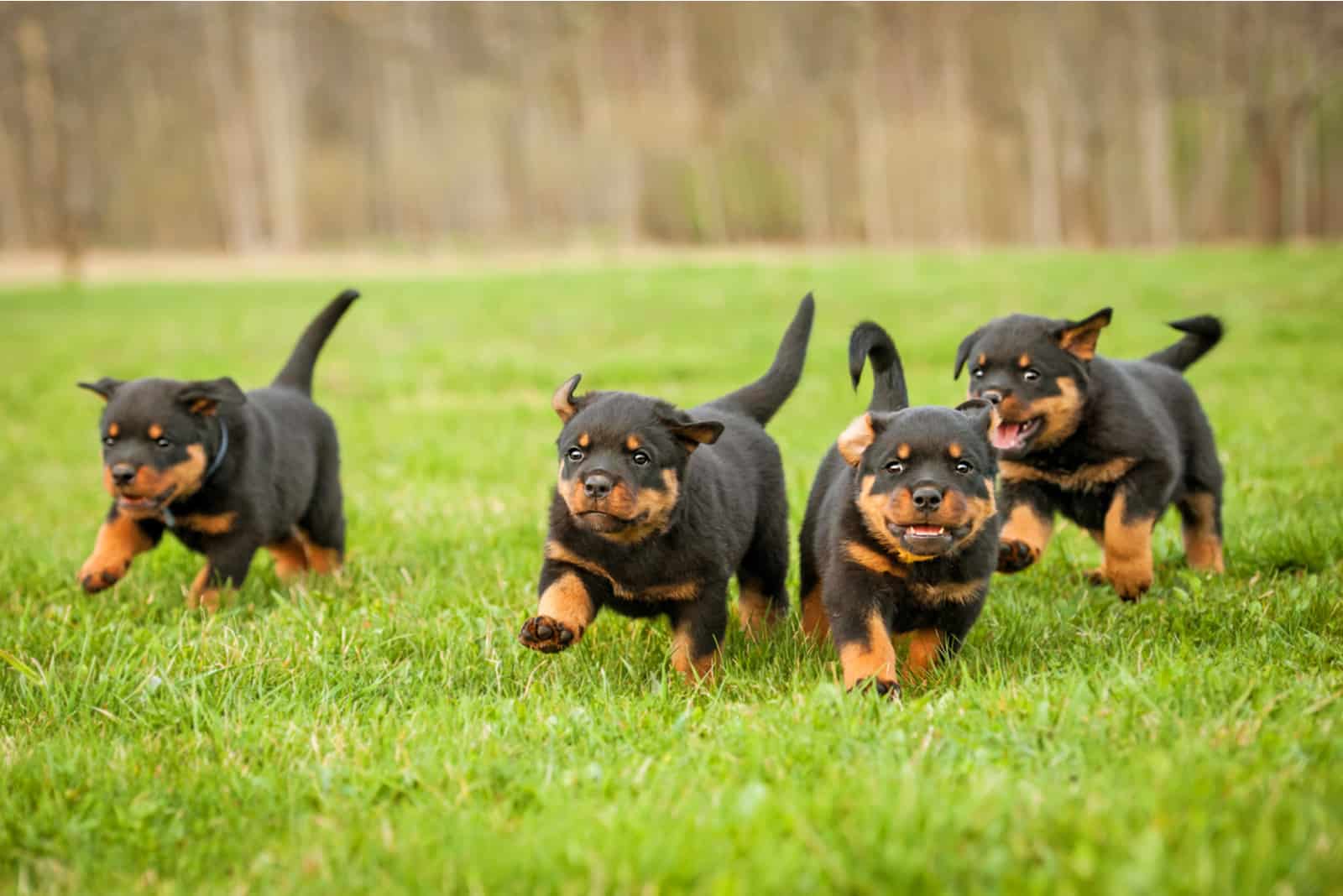
The Rottweiler dog breed is notorious for its enormous puppy growth spurt that leads to its large size.
Sometimes, Rottie owners have difficulties with keeping track with their Rottie puppy growth. This is why tools such as this Rottweiler growth chart come in handy.
Even though these numbers may or may not be completely relatable to your Rottie, they will show approximate Rottweiler measurements during its growth.
I would like to advise you to seriously think before such a large dog. And I’m saying this because Rotties require a very spacious environment. Rottweiler puppies are perfect for people with gardens and large houses.
However, keeping a Rottie in a small apartment is also possible, but only if you provide it with a lot of quality exercise outside.
If you have decided to get a new Rottweiler puppy, take your time to find a reputable Rottweiler breeder in your area.
Keep your Rottie happy and healthy by following this Rottweiler growth chart!
Related Content
• Doberman Growth Chart: Growing Up Healthy
